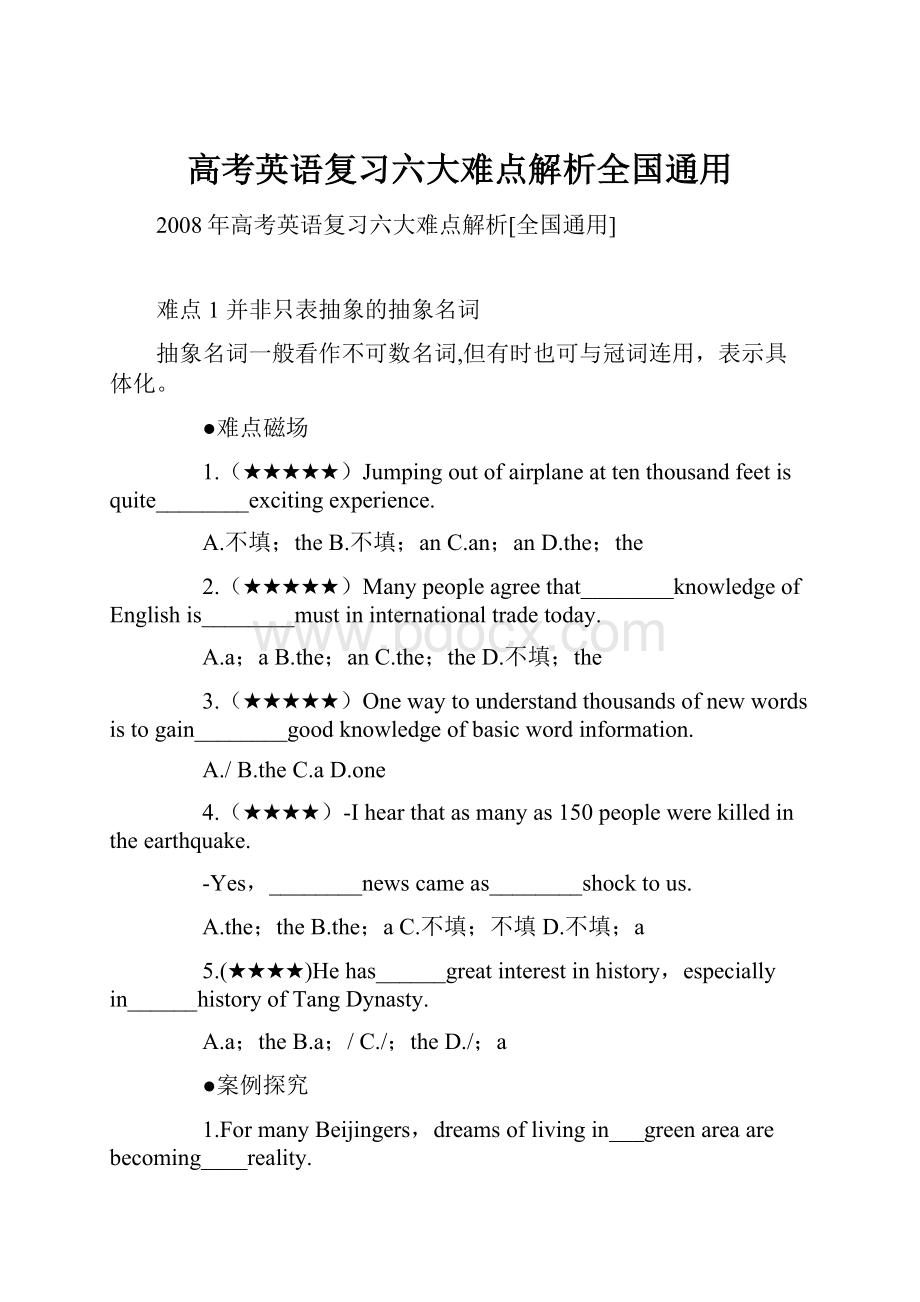高考英语复习六大难点解析全国通用.docx
《高考英语复习六大难点解析全国通用.docx》由会员分享,可在线阅读,更多相关《高考英语复习六大难点解析全国通用.docx(33页珍藏版)》请在冰豆网上搜索。

高考英语复习六大难点解析全国通用
2008年高考英语复习六大难点解析[全国通用]
难点1并非只表抽象的抽象名词
抽象名词一般看作不可数名词,但有时也可与冠词连用,表示具体化。
●难点磁场
1.(★★★★★)Jumpingoutofairplaneattenthousandfeetisquite________excitingexperience.
A.不填;theB.不填;anC.an;anD.the;the
2.(★★★★★)Manypeopleagreethat________knowledgeofEnglishis________mustininternationaltradetoday.
A.a;aB.the;anC.the;theD.不填;the
3.(★★★★★)Onewaytounderstandthousandsofnewwordsistogain________goodknowledgeofbasicwordinformation.
A./B.theC.aD.one
4.(★★★★)-Ihearthatasmanyas150peoplewerekilledintheearthquake.
-Yes,________newscameas________shocktous.
A.the;theB.the;aC.不填;不填D.不填;a
5.(★★★★)Hehas______greatinterestinhistory,especiallyin______historyofTangDynasty.
A.a;theB.a;/C./;theD./;a
●案例探究
1.FormanyBeijingers,dreamsoflivingin___greenareaarebecoming____reality.
A.a;aB.the;theC.不填;不填D.the;不填
命题意图:
表面看本题考查学生对冠词的用法,其实也考查了学生对抽象名词具体化的掌握,属于五星级题目。
知识依托:
抽象名词并非都作不可数名词。
错解分析:
D选项迷惑性较大,许多同学会认为reality为抽象名词,不能用a。
解题方法与技巧:
抽象名词或物质名词前或后加上表示性质类别的修饰词,指概念的"一种""一类""一次"等时,可用不定冠词,例如:
Physicsisascience.
答案:
A
2.Thepolicehave________powertoarrestbadpeopleby________law.
A.the;theB.a;aC.the;不填D.不填;the
命题意图:
考查学生对抽象名词具体化的理解,属于四星级题目。
知识依托:
定冠词与抽象名词连用,特指双方都了解的人或事。
错解分析:
许多学生会认为D正确,认为power是抽象名词,故不能用冠词。
解题方法与技巧:
toarrestbadpeople是power的定语,故此处用the表示特指。
答案:
C
●锦囊妙计
1.不定冠词与抽象名词连用表示:
①一种、一场或某个动作的一次、一番。
例如:
Itwasawar,havealook,haveatry。
②某一品质的具体行动。
例如:
Thankyou,Tim.Youhavedonemeakindness.
③引起某种情绪的事。
例如:
It'sapleasuretoworkwithyou.It'sapitythatyoucan'tswim.
2.定冠词与抽象名词连用,特指某一时、某一次的行动或情绪,或说话的双方都了解的人或事。
3.注意:
有些词组中,有没有冠词含义是不同的。
试比较:
●歼灭难点训练
1.(★★★★)Heis________(help)tome.
2.(★★★★)Nowadaysmanyyoungpeoplegetinto________habitofsmokingin________publicandcan'tkickit.
A.the;theB./;/C./;theD.the;/
3.(★★★★★)-Thenewsisspreadingfrommouthtomouth.
-Yes,it'sbecome________talkof________town.
A.a;aB.the;/C.the;theD.a;/
4.(★★★★★)Infaceof________failure,itisthemostimportanttokeepup________goodstateofmind.
A./;aB.a;/C.the;/D./;the
5.(★★★★★)Havingreceived________trainingoftheMs.Company,hewasoffered________importantpositioninmanagement.
A.the;anB.不填;anC.the;不填D.a;a
6.(★★★★★)In________SaharaDesert,________rainwasscarce,butinmyhometownthereis________heavyrainnowandthen,andtheriveraroundthetownrisesalotafter________.
A.the;the;a;aheavyrainB.the;/;a;heavyrains
C./;/;/;aheavyrainD.the;the;a;heavyrains
7.(★★★★)Thebuildingwascompletedin________Septemberof1956notin________October,1955.
A./;theB.the;theC./;/D.the;/
难点2 冠词的非前位用法
限定语与所修饰的中心名词的关系一般顺序是:
冠词+表示大小尺寸的限定词+表示颜色的限定词+表示原材料的限定词+中心名词。
但在某些固定结构中,冠词放在了形容词之后。
●难点磁场
1.(★★★★)-Whatabout________book?
-It'stoodifficult________book.
A.a;aB.a;theC.the;theD.the;a
2.(★★★★★)________Beijingyouseetodayisquite________differentcityfromwhatitusedtobe.
A.The;不填B.The;aC.不填;theD.A;a
●案例探究
1.Peterwon'tdriveustothestation.Hehas________totakeusall.
A.averysmallcarB.toosmallacar
C.atoosmallcarD.suchasmallcar
命题意图:
考查学生对冠词不放在第一位的固定结构的掌握,属于四星级题目。
知识依托:
不定冠词放在too+形容词之后。
错解分析:
C迷惑性较大,学生都学过too+adj./adv.+to…结构,但对于too+adj.+n.+to…结构不熟悉。
解题方法与技巧:
名词前修饰语一般正常语序为:
不定冠词+形容词+名词。
但有些固定结构需注意,如too+adj.+a/an+n.。
答案:
B
2.Exerciseis________asanyothertoloseunwantedweight.
A.sousefulawayB.asausefulway
C.asusefulawayD.suchausefulway
命题意图:
考查学生对冠词不放在第一位的固定结构的掌握,属五星级题目。
知识依托:
不定冠词放在as+形容词之后。
错解分析:
A、B迷惑性较大,so…as结构常用于否定句和疑问句,故不能选A、B。
解题方法与技巧:
名词前修饰语正常语序为:
不定冠词+形容词+名词,但有些固定结构需注意,如:
as+adj.+a/an+n.
答案:
C
●锦囊妙计
1.不定冠词用在quite,rather,many,half,what,much等词之后。
例如:
Heisratherafool.
-Whatdidyouthinkoftheconcert?
-Oh,itwasquiteasuccess.
2.不定冠词用在so(as,too,how)+形容词之后。
例如:
Sheisascleveragirlasyoucanwishtomeet.
It'stoodifficultabookforustoread.
注意:
以元音音素开头的名词前加不定冠词时用"an"。
例如:
anapple。
即使单词拼写以辅音字母开头,但该词的读音是元音音素开头,加不定冠词时也要用"an",例如:
anhour,anhonestboy;反之,拼写以元音字母开头,但读音是辅音,加不定冠词时要用"a",例如:
auniversity。
3.so…that与such…that:
①so…that和such…that都作"如此……以致"解,that引导结果状语从句。
常见句型如下:
so
②such…that和so…that有时可以换用,条件是such所修饰的名词必须是一个单数可数名词,且该名词还带有表性质的形容词。
转变公式如下:
sucha/an+形容词+名词→so+形容词+a/an+名词。
例如:
Heissuchagoodstudentthatwealllikehim.→Heissogoodastudentthatwealllikehim。
但是,如果是不可数名词或复数可数名词,则只能用such,不能用so修饰。
例如:
Itwassuchbadweatherthathehadtostayathome。
③如果复数名词前有many,few,不可数名词前有much,little等表示量的形容词时,应该用so而不用such。
如:
I'vehadsomanyfallsthatI'mblackandblueallover.
MrWhitegotsolittlemoneyamonththathecouldhardlykeepbodyandsoultogether(维持生活)。
但little不表示数量而表示"小"的意思时,仍用such。
例如:
Theyaresuchlittlechildrenthattheycannotcleanthehousebythemselves.
●歼灭难点训练
1.(★★★★)Annis________girl.
A.quiteabrightB.aquitebright
2.(★★★★).It's________day.
A.arathercoldB.ratheracoldC.acoldrather
3.(★★★★★)________ishere.
A.ManyaboyB.Manyboys
4.(★★★★)多么聪明的一个男孩。
5.(★★★★)Englishis________totheworldasotherlanguages.
A.sousefulabridgeB.asausefulbridge
C.asusefulabridgeD.suchausefulbridge
难点3不定代词的固定表达
不定代词具有名词和形容词的性质,并有可数与不可数、单数与复数的区别,用时需慎重。
●难点磁场
1.(★★★★)-Is________here?
-No,BobandTimhaveaskedforleave.
A.anybodyB.somebodyC.everybodyD.nobody
2.(★★★★)Theywereverytired,but________ofthemwouldstoptotakearest.
A.anyB.someC.noneD.neither
3.(★★★★)Ihopethereareenoughglassesforeachguesttohave________.
A.itB.thoseC.themD.one
4.(★★★★★)-Whenshallwemeetagain?
-Makeit________dayyoulike;it'sallthesametome.
A.oneB.anyC.anotherD.some
5.(★★★★★)Iagreewithmostofwhatyousaid,butIdon'tagreewith________.
A.everythingB.anythingC.somethingD.nothing
(NMET1997)
6.(★★★★★)SarahhasreadlotsofstoriesbyAmericanwriters.Nowshewouldliketoread________storiesbywritersfrom________countries.
A.some;anyB.other;someC.some;otherD.other;other
7.(★★★★)-CanyoucomeonMondayorTuesday?
-I'mafraid________dayispossible.
A.eitherB.neitherC.someD.any
8.(★★★★★)Dr.BlackcomesfromeitherOxfordorCambridge,Ican'tremember________.
A.whereB.thereC.whichD.that
9.(★★★★★)-Arethenewrulesworking?
-Yes.________booksarestolen.
A.FewB.MoreC.SomeD.None
10.(★★★★)Fewpleasurescanequal________ofacooldrinkonahotday.
A.someB.anyC.thatD.those
●案例探究
1.Ifyouwanttochangeforadoubleroom,you'llhavetopay________$15.
A.anotherB.otherC.moreD.each
(NMET2000)
命题意图:
本题考查学生对"又""再"的英语表达方式的掌握,属五星级题目。
知识依托:
"another+数词+复数可数名词"表示在原有基础上多出的数量。
错解分析:
B、C迷惑性较大。
因other、more也有"再""又"之意,但位置与another不同。
解题方法与技巧:
必须记清表达方式,数词+more/other+复数可数名词。
答案:
A
例:
I'vegotanotherthreebooks.
I'vegotthreemore/otherbooks.
2.-Whydon'twetakealittlebreak?
-Didn'twejusthave________?
A.itB.thatC.oneD.this
(NMET2000)
命题意图:
考查学生对表示特指事物的代词和表示泛指事物的代词的区别,属四星级题目。
知识依托:
one代替单数可数名词,但泛指物。
错解分析:
A项选择迷惑性较大。
因人称代词it和不定代词one都可以代替单数可数名词,但it指特定事物。
解题方法与技巧:
答语中用one泛指第一个对话者询问的alittlebreak。
答案:
C
●锦囊妙计
不定代词的种类较多,用法各异,下面分别进行介绍。
1.one,some与any的用法
one可以泛指任何人,还可以在形容词和that、this等词后代替刚提过的可数名词,其复数形式为ones,可用作主语和宾语;one's是它的物主代词形式,可用作宾语;oneself是它的反身代词形式,可用作宾语。
some和any通常用作定语,都可用来修饰可数与不可数名词、单数或复数名词。
some用于单数可数名词前,表示"某一"。
some用于数词前,表示"大约"。
some一般用于肯定句,any多用于疑问、否定句中。
例如:
Oneshouldwashoneselfregularly.
ThisfilmisnotasgoodastheoneIsawyesterday.
Hethoughtitovercarefullyandconcludedthatheavyobjectsalwaysfellfasterthanlightones.
Wehavesomefoodleft.Haveyouanybooks?
Idon'thaveanybooks.
注意:
①some可用于表达邀请或请求、预期的答案是肯定的或鼓励对方给予一个肯定的答复的问句。
例如:
Couldyouletmehavesomecoffee?
(请求)
Wouldyoulikesomebananas?
(邀请)
②some和any可用作主语和宾语。
例如:
Somearesinging,othersaredancing.(主语)
DoesanyofyouknowMrWang?
(主语)
Idon'tlikeanyofthebooks。
(宾语)
③some,any,every,no与one,body,thing构成的合成代词都作单数看待。
另外,some的合成代词一般用于肯定句,any的合成代词一般用于否定句、疑问句和条件从句。
例如:
Didanybodyaskforyououtside?
Thereissomebodywaitingforyou.
2.each,every的用法
①each强调个体,可以充当宾语、定语、主语和同位语,every强调整体,相当于汉语的"每个都",在句中只作定语。
例如:
Theteacherhadatalkwitheachofthem.(宾语)
Eachofushastwoboxes.(主语)
Wehavetwoboxeseach.(同位语)
Eachboyhasabike.(定语)
Everyonehasstrongandweakpoints.(定语)
②each所代表的数可以是两个或两个以上,而every所指的数必须是三个以上。
例如:
Eachofthetwohaswonaprize.EverystudentintheclasslikesEnglish.Thereisalineoftreesoneachsideoftheriver.
3.none和no的用法:
①no=noany在句中作定语,修饰可数或不数名词。
none在句中作主语或宾语。
none不能用来说明两个人或物。
例如:
Thereisnowaterinthewell(井).(定语)
Noneofthemknowthestory.(主语)
Iknownoneofthem.(宾语)
②none代替不可数名词作主语时,谓语动词用单数形式;代替可数名词作主语时,谓语动词可用单数,也可用复数。
例如:
Noneofthestudentsare(is)afraidofdifficulties。
③none不能回答who的问题,可回答howmany或howmuch的问题,例如:
(误)-Whoisintheclassroom?
-None.(改None为Noone或Nobody)
(正)-Howmanystudentsarethereintheclassroom?
-None.
4.many和much的用法
many和much都表示"许多",many修饰可数名词,much修饰不可数名词,都可用作主语、宾语和定语。
例如:
Manyofthestudentsoftengoshopping.(主语)
Ihavemuchtodo.(宾语)
Thereisnotmuchwaterinthecup.(定语)
much有时用作状语,例如:
Helikesplayingfootballverymuch。
(状语)
5.few,little;afew,alittle的用法
①few和little表示没有多少,含否定意义;而afew与alittle表示有一些,有几个,含肯定意义。
另外,few与afew修饰可数名词,而little与alittle修饰不可数名词,它们在句中常用作定语、主语和宾语。
例如:
HeknowsalittleEnglish.(定语)
Hehasmanybooks.Butfewareinteresting.(主语)
IknowalittleaboutJapanese(宾语)